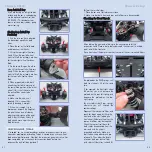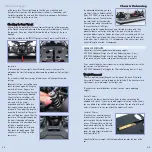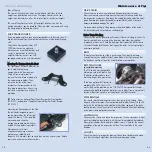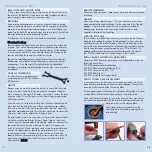
The one-way differential should be used only on high traction surfaces where
braking ability by the rear wheels alone is sufficient.
Keep in mind that when using the one-way pulley with a loose setting, or
when using the one-way differential, no drag brake should be used. Most
racers will also find it more convenient to set their radio to give less braking
action (use the throttle EPA setting). This will prevent the rear tires from
locking unexpectedly.
FRONT SOLID AXLE (available option)
The optional front Alu Solid Axle (#30 5180) is
best suited for carpet tracks or short tracks
with a lot of traffic, where maximum effective
braking is required. Off-power steering is
reduced.
The front solid axle should be used only at the front
of the car, with a rear differential and original solid
central layshaft. Using this configuration, the car achieves
maximum 4WD braking, while being very stable and easy to drive.
SHOCKS
Shocks, or shock absorbers, are a part of the suspension
that allow the wheels to keep as much contact
with the running surface as possible. The T1R
features unique 4-step externally-adjustable
racing shocks that do not require you to
change pistons or change shock oil to alter
the damping. Damping, mounting position, spring
tension, and spring preload are all characteristics that determine how the
shock performs.
S
Sp
prriin
ng
gss
The shock springs support the weight of the car, and different spring
tensions determine how much of the car's weight is transferred to the wheel
relative to the other shocks. Spring tension also influences the speed at
which a shock rebounds after compression.
Spring selection depends on the whether the track is fast or slow, or has high
or low traction.
Final Adjustments
10
9
T
RACK SURFACE
O
NE
-
WAY PULLEY
O
NE
-
WAY FRONT
LOCKED
LOOSENED
DIFFERENTIAL
Low traction
Medium traction
(slow, tight corners)
High traction
(slow, tight corners)
High traction
(fast, sweeping corners)
✔
✔
✔
✔
✔
Final Adjustments
ONE-WAY PULLEY (available option)
To be able to adjust the over-steer/under-steer
balance, we suggest using the #305500 Main
Layshaft With Adjustable One-Way. The one-
way pulley allows the front wheels to spin
independently of the rear wheels. Our unique
one-way system lets you determine how freely the
front wheels spin. A plastic locknut on the main layshaft can
be fully tightened to lock the front wheels to the rear (full-time
4WD) or loosened to let the front wheels “free-wheel” off power (4WD on
throttle, RWD off throttle). Or it can be set anywhere in between to match
your driving style.
LLo
oo
osse
err O
On
ne
e--W
Wa
ayy P
Pu
ulllle
eyy
The main effect of a looser one-way
pulley is more off-power steering.
However, this should only be done
on high-traction surfaces or large
tracks where minimal braking is
required. Since only the rear wheels
are used for braking, spins induced
by a locked rear tire are more likely.
One of the benefits of a looser one-
way pulley is less drive train drag at
maximum speed, which can increase
top-end speed.
To loosen the one-way pulley, hold the locknut securely with pliers, then
rotate the spur gear backward. The locknut will back away from the fixed
pulley and move away from the pullies.
NOTE: Pull the fixed pulley away from the one-way pulley to let the front belt
move freely without binding.
T
Tiig
gh
htte
err O
On
ne
e--W
Wa
ayy P
Pu
ulllle
eyy
The one-way pulley should be
tightened under slippery conditions,
if you need to reduce steering, or if
heavy braking is needed.
To tighten the one-way pulley, hold the
locknut securely with pliers, then rotate
the spur gear forward. The locknut will
tighten against the fixed pulley and
move toward the pullies.
ONE-WAY FRONT DIFFERENTIAL (available option)
The optional front one-way differential
(#30 5101) has independent one-way bearings
for each front wheel so the two front wheels can
rotate at different rates like a regular differential.
On throttle, if one wheel loses traction, the other
still gets power to pull the car through the turn.
Under braking, the front wheels spin freely, giving
better cornering ability but reducing overall braking ability.
Summary of Contents for T1R Raycer
Page 1: ......






































